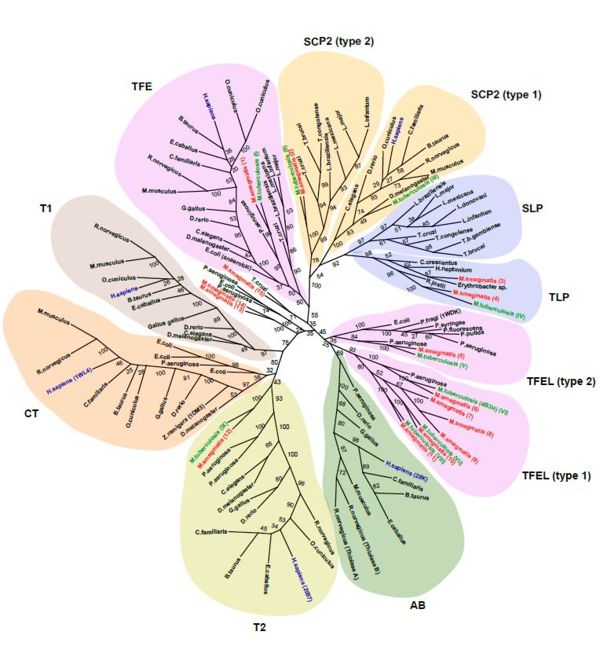Introduction
Thiolase is best known as a key enzyme in the fatty acid degradation
pathway, also known as the β-oxidation pathway. However, in the human
metabolism at least six thiolases (Table 1) have been
characterized. For most of these thiolases the structures are known (Table 2). Each of them important in different pathways, and in
different cell organelles. Some thiolases are dimers, some thiolases are
tetramers, being dimers of dimers. Thiolases are involved, either in
degradative pathways (T1, AB, TFE: E.C. 2.3.1.16 or SCP2: E.C. 2.3.1.176) ([1], or in biosynthetic pathways
(T2, CT: E.C. 2.3.1.9). This division is somewhat arbitrary as all thiolases
are sequence related to each other and catalyse the reaction in both directions.

The above scheme shows the degradative reaction catalysed by thiolase. In this the acetoacetyl-CoA is degraded with CoA as cosubstrate, by which two molecules of acetyl-CoA are formed. Each thiolase catalyzes this reaction in both directions, but the
equilibrium is far much favoring the degradative direction
(Keq is 105, favoring the degradation). The
reaction is catalyzed by the enzyme as a two step reaction. In the first step a fully conserved
active site cysteine, Cys89 is acetylated, liberating acetyl-CoA. In
the second step the acetyl-moiety is transferred to CoA.
The best studied thiolase is the bacterial Zoogloea ramigera thiolase,
which is a biosynthetic thiolase and which catalyzes the formation of
acetoacetyl-CoA from two molecules of acetyl-CoA. The enzymological
properties of Zoogloea ramigera thiolase have been extensively
characterized by C.T Walsh and coworkers[2] and more recently its
structural enzymological properties have been characterized also.[3][4] The residue numbering on this page refers to the Zoogloea ramigera
thiolase sequence, and the structural information concerns the 1DM3 structure.
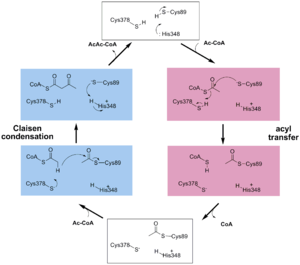
Figure 1. The catalytic cycle of thiolase. The synthetic direction is the clockwise direction. In this direction first Cys89 is acetylated by acetyl-CoA. In the second step this acetyl group is transferred to acetyl-CoA, the Claisen condensation.
Table 1. The six identified human thiolases.
| Intracellular localization
| Mode of assembly
| Function
| Comment: thiolase protein code (gene sequence code)
|
| cytosol
| α4 | synthesis | CT (THIC)
|
| mitochondria
| α4 | synthesis and degradation | T2 (THIL) Many point mutation variants related to metabolic disorders have been characterized.[5]
|
|
| α4 | degradation | T1 (THIM)
|
|
| α4β4 | degradation | trifunctional enzyme, TFE (ECHB)
|
| peroxisome
| α2 | degradation | A/B (THIK)
|
|
| α2 | degradation | SCP2 (NLTP)
|
The reaction mechanism
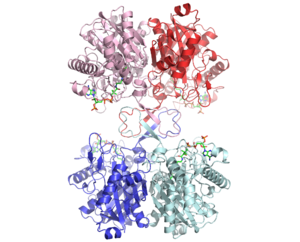
Figure 2: the tetramer (1DM3)
The complete catalytic cycle of the Zoogloea ramigera thiolase is
shown in Figure 1. This thiolase is a tetramer, indeed a dimer of
dimers, as shown in Figure 2. The active site is deeply
buried. It is constructed by , which provide
the catalytic nucleophile (Cys89), the base (Cys378), as well as
Asn316 and His348. Asn316 and His348 are key residues of the active
site geometry: a Asn316-Wat82 dyad, together with His348 make , stabilizing the CoA-thioester enolate intermediate. The hydrogen bond donors of oxyanion hole 1 are Wat82 and NE2 (His348). This enolate is formed from acetyl-CoA after proton
abstraction by the catalytic base, Cys378 (Figure 3).

Figure 3: Formation of the thioester enolate. A base is required for this proton abstraction. In thiolase this is Cys378. The oxyanion hole is formed by the Wat82-Asn316 diad and His348.
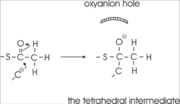
Figure 4: Formation of the tetrahedral intermediate thioester oxygen atom. The oxyanion hole is formed by two main chain NH-groups, from residues Cys89 and Gly380.
His348 has a
dual role, as it also activates Cys89 for nucleophilic attack.
A further key element of the active site geometry is , which stabilizes the tetrahedral intermediate thioester oxyanion. This oxyanion hole is formed when the C2-atom of acetyl-CoA
reacts with the carbonyl-atom of the acetyl-cysteine thioester (Figure 4). The hydrogen bond donors of oxyanion hole 2 are N (Cys89) and N (Gly380).
The importance of the Asn316-Wat82 diad and His348 for the
oxyanion hole 1 stabilization of the transition state in the Claisen
condensation reaction has been confirmed by recent studies by
Merilainen et. al.[4]
These key elements of the thiolase reaction mechanism have been
captured in the 1DM3 crystal structure,[6] which is a complex of
acetyl-CoA complexed with the acetylated enzyme (Figure 5). This
crystal form is grown at pH5. At this pH the catalytic base, Cys378,
is predicted to be always protonated, independent of the ligand bound
in the active site. Therefore it is unable to abstract the proton from
the methyl group of acetyl-CoA, and therefore the reaction
intermediate as shown in Figure 5 has been captured.
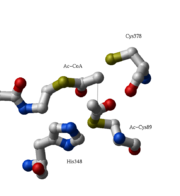
Figure 5. The captured intermediate (1DM3). In the active enzyme Cys378 is predicted to abstract a proton from the acetyl-CoA methyl group and in this way the Claisen condensation reaction is initiated. In this 1DM3-complex the pH is around 5 and therefore the intermediate has been trapped, as Cys378 will be predominantly protonated.
There are several structures known of the Zoogloea ramigera thiolase
complexed with the intermediates of the reaction cycle.[3] It is
interesting to point out that no gross structural changes of loops or
side chains have been detected. For example, the only structural
change with the apo structure (1DLU) is the small movement of the
Cys89 side chain towards the His348 side chain, by which it is assumed
that Cys89 is deprotonated and therefore activated.
Diseases
The best characterized thiolase deficiencies concern mutations in the
T2 thiolase gene. T2 is important in the synthesis of ketone bodies
(in the mitochondria of the liver) as well as for the breakdown of
these ketone bodies, for example in the mitochondria of the brain and
heart. The T2 deficiency affects the breakdown of these ketone bodies
as is detected by accumulation of the oxidized ketone bodies in the
blood stream, causing ketoacidosis. This suggests that some other
thiolase is able to replace the synthetic, mitochondrial T2 thiolase
function, but not the degradation function. The T2 deficiencies have
been studied much by Dr. Fukao (Gifu University, Gifu, Japan).[5]
Evolution
Thiolase turns out to be the founding member of a large superfamily of
enzymes, referred to as the thiolase superfamily.[7]
Key members of this superfamily are the KAS-enzymes. The KAS-enzyme is the first
enzyme in the fatty acid synthesis pathway. It has the same fold as
thiolase, and also the nucleophilic cysteine is conserved. Also
conserved in the KAS enzymes are the two residues which built oxyanion
hole 1 in thiolase. It has been noted that in the superfamily the
Asn316 and His348 either occur as a NH-pair (like in thiolase), or as
an HH-pair, or as an HN-pair, the NN-pair is never observed. Each of
the superfamily members also have the fully conserved cysteine
corresponding to Cys89. Therefore the members of the superfamily can
be divided into three categories, being CNH, CHH, and CHN.[8] In
the bacterial thiolase, extensive mutagenesis followed up by
structural enzymology[4] has confirmed that the CNH-triad of
Zoogloea ramigera is indeed important for the function of oxyanion
hole 1. These fingerprint sequences are in loops close to the active site. The catalytic base, Cys378 in the Zoogloea ramigera thiolase is in a fourth catalytic loop, and in most thiolases this is part of a conserved CxG-motif, except in the SCP2-thiolase subfamily [9]. More recently a sequence alignment using 130 thiolase and thiolase-like sequences
(SLPs and TLPs) has been reported[10]. The phylogenetic tree calculations using this sequence alignment groups these sequences in several clusters, as shown in Figure 6. Each of the observed sequence clusters has
a unique combination of the four sequence fingerprints.







